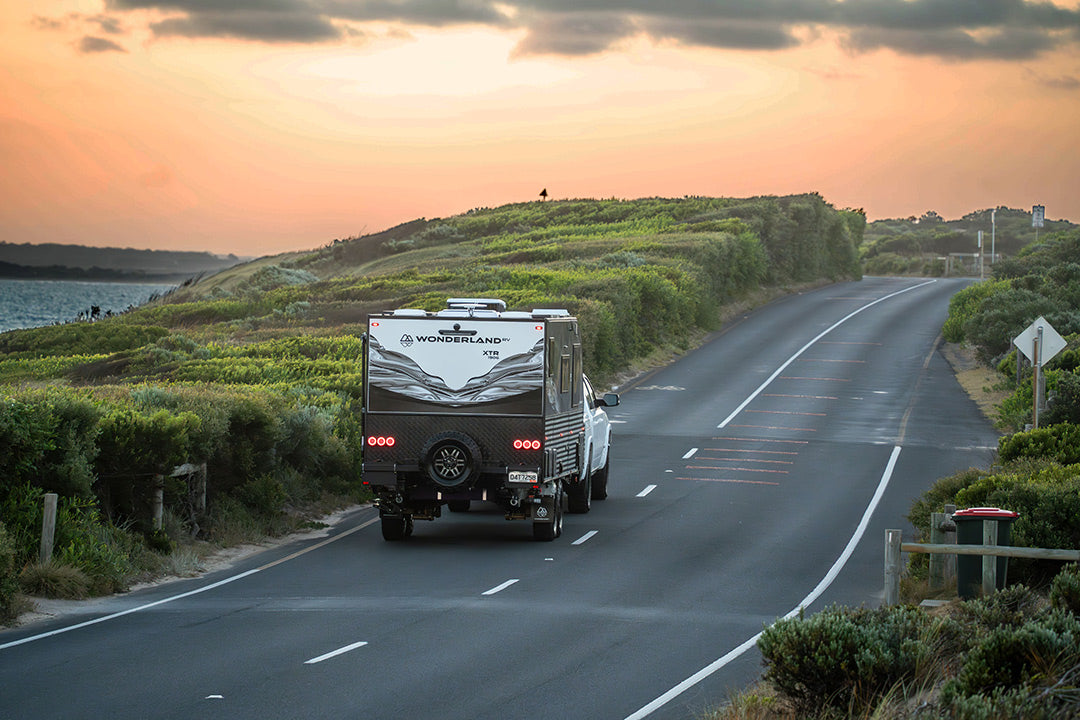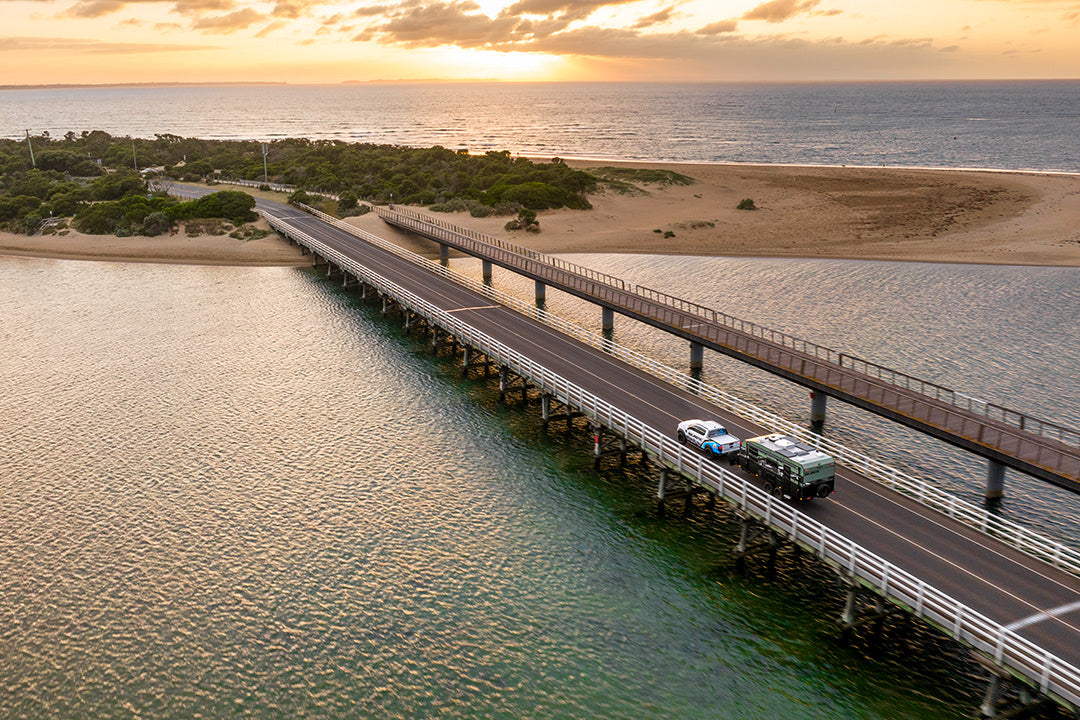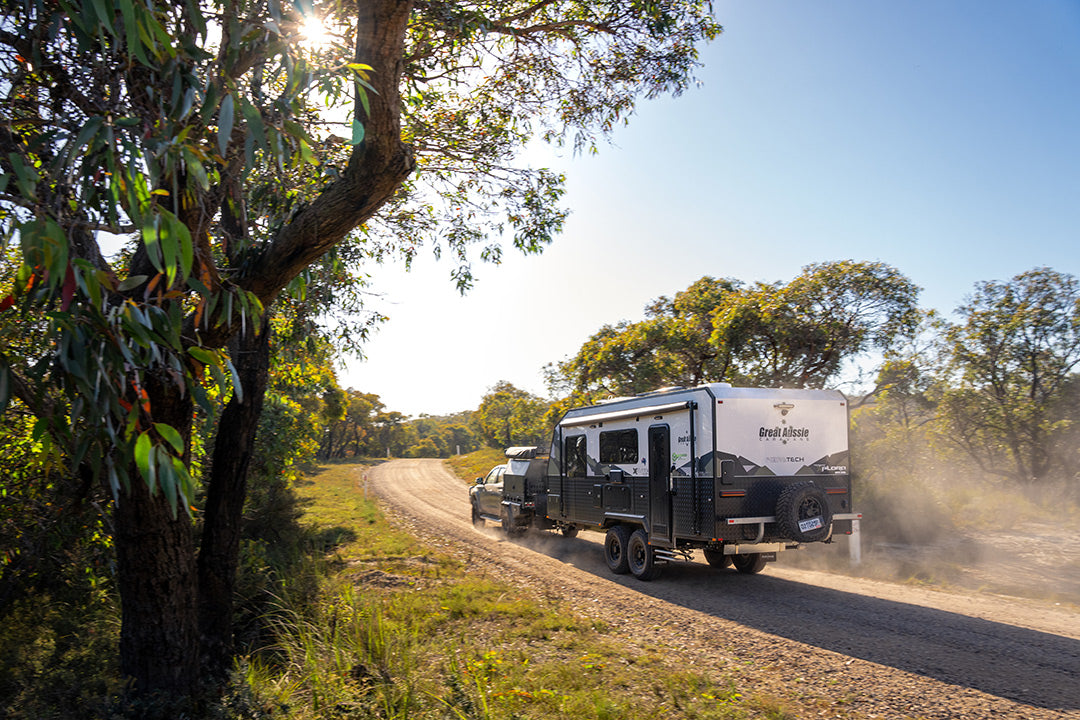High Country

Real or fool’s gold? It’s a question everyone must answer at some point, particularly when testing out a couple of hybrids.
Figuring it out requires a hands-on approach. You can’t really tell if you’re dealing with genuine sparkle or false lustre when you’re looking from afar. That’s why we like to test products on the field.
Of course, the field itself — that is, the testing grounds — can be real or fool’s gold too. In terms of how challenging the landscape is, but also in terms of how well suited it is to camping and adventurous travel. We like to ask: is this a place our readers would like to travel, and can we help them to experience it?
Back in March, we took a couple of hybrids through the major destinations of the Victorian High Country: the Goldstream 1500 Series Remote RK ST and Trailblazers Stuart 5.5. Our route included all the famous places with established reputations — think Dargo, Mt Hotham, Mt Terrible — to us, as to many, this course was already stamped in gold, in big shining letters.
Then, at the last minute, the area caught fire. The maps showed the extent of the uncontrolled and expanding blaze. On the very cusp of our adventure, our planned itinerary became too dangerous, perhaps flat-out impossible.
But we all had our hearts set on adventure. And there was, after all, a plan B: a lesser-known route through the Mt Baw Baw region, from the township of Rawson to Woods Point and beyond along the unsealed tracks linking the two.
A little bit of pre-trip reconnaissance from the team reassured us of the suitability of this course. But still, before properly immersing ourselves, it was hard to tell exactly what we were dealing with — real or fool’s gold?
THE 1800s INTACT
After arriving at the Mountain Rivers Tourist Park in Rawson late on Monday night, we woke up on Tuesday and headed for breakfast at the Erica Post Office, before driving out to Walhalla. We made our way along winding roads cut into the sides of mountains, surrounded on each side by towering trees with dead-straight trunks, permitting occasional glimpses at dark, flowing rivers down below. Rather suddenly, we arrived in the town. How oddly situated it is in the depths of the valley, wedged between steep hillsides.
History is usually buried beneath more modern developments, but not so in Walhalla. The town looks like it’s been taken straight from the 1800s, thanks to its heritage-listed buildings, abandoned machinery and slopes showing the scars left by pressurised water hoses used in mining. These reminders of a bygone era turned our attention to the past, and inspired a fascination for the region's history that would stay with us for the rest of the trip.
Gold was first discovered in the area back in 1859, by a gentleman called Edward William Gladman. Gladman, keen to secure the profit he felt was his share, put in his claim as first discoverer to the police, writing to them: “As I have been the first to discover and make public what I believe to be a payable field in this part of Gippsland, I am in hopes that, if the Government allows a reward for such discoveries, that I am entitled to one.” The government did allow; Gladman snagged himself 250 pounds.
GOLDEN OPPORTUNITIES
Gladman's discovery brought flocks of excitable miners to the region, generating an absolute frenzy of claims left, right and centre. Every man and his dog was finding a hint of gold and putting in claims of discovery to ensure he was not beaten to the punch. Rather than the lone wolves one might picture, men usually wound up working for one of many rapidly appearing companies, on a set wage between two to four pounds a week. The miners adopted various methods, from puddling machines and sluicing, to more advanced pump systems and stamp mills.
Hot on the tails of the miners were similarly opportunistic businesses, seeking to make a fortune supplying the men. And so proper, resourced communities were formed, particularly near the more successful mines. One of these was near Stringy Creek, and it became known as — you guessed it — Walhalla.
On gold, or more accurately on the promise of gold, the town blossomed — with the formation of general stores, bakeries, schools, a telegraph line, a post office, a bank, a stock exchange and a newspaper.
It wasn’t paradise. Miners were working around the clock, often 48 hours a week, with shifts starting at 8am, 4pm and midnight. Sickness and death plagued the town — mining accidents, breathing disorders, dysentery, cholera and typhoid, all kept a steady procession of mourners ending up in the local cemetery. And as for the gold; it came and went, but inevitably, it went and went and went. The population wavered accordingly. At one point in the late nineteenth century, 2000 people lived here, but by 1918, only about 400.
Nowadays, the town’s permanent population is 20. While we were there, we saw and waved at a few folks on the street who were walking dogs, but it was hard to reconcile the silence with the scenes which once prevailed here. To think that, where we were standing, a reverent flock of miners and their partners and children had once stood, watching as gold was loaded from the Bank of Victoria into the export cart — sometimes more than 100kg of it — and then carted away by horse down the dirt road for sale in Traralgon, with the cart guarded by police at all times. The Kelly Gang were making headlines, after all.
ERICA AND RAWSON
For us, it was back to Rawson, to set up on flat ground. Here, Matt and Phil from Trailblazers, and John and Ann from Goldstream, showed us through their hybrid campers. We got to ask all of the important questions and they got to answer them — how long could these beasts survive off-grid? What luxuries resided inside their tough exteriors? It was a great opportunity for the folks behind the brands to explain how everything worked and to show off all the best features of their hybrids.
Nothing could beat a beer and a feed after a big day like this; we were all feeling eager to debrief and chat about what we’d experienced. We headed to the old-school Erica Pub and discovered, yet again, another historical delight.
The interior of the pub is made of varnished wood, with various farming and other relics hanging from the walls and the roof, including chainsaws with the names of their previous owners. Across the other side, down a hallway, but audible from where we sat, a pet cockatoo squawked joyously.
Erica was a relatively late addition to the mix. In anticipation of the railway to Walhalla to be completed in 1910 that would run through this area, the township of Erica was surveyed. William Murie applied for a roadside licence and opened the Erica Hotel in 1915. Yet this place, where we were dining now, could well have been called the ‘Harris’ Hotel, after the man who had fought hardest for the railway — had not the Post Office, where we’d had breakfast, protested that a town of the same name existed in WA.
In spite of its origins in the gold booms, Erica ended up being more about timber, and it prospered, for a time, on the back of sawmills. This hotel where we sat now, raising a beer to our lips, was the same hotel mill workers had raised beers to their saw-dust coated lips in the hey-day of the industry. And indeed, it was long a tradition that those out of work could linger near the station, to be shouted a bevvy by employed men who were feeling generous. The closure of the railway in the 1950s hurt Erica, but it lives on now as a small-scale town run by loyal and hardworking locals. The lady who prepared our lunches for the day just gone, and the day to come, was very industrious indeed; she was also preparing the lunches for firefighters working nearby in the burning parts of the High Country.
Interestingly, Rawson experienced a naming debacle too. The town, which sits just 4km north of Erica, was created in the late 1970s to support water projects going on in the area, supplying H20 to Melbourne and surrounds. It was going to be called ‘Robertson’, after a recently retired chief engineer in the water business, but locals protested that the town should recognise gold mining history instead — and so it did.
Rawson was named after one George Rawson, an Englishman with 11 children who had settled in the region more than 100 years prior, and who had founded his own gold company. His children and their children in turn went on to play various important roles for the region.
We were all off to bed pretty early, resting up for a big day of offroading tomorrow. Thus far, the journey had been more about historical stories, which were popping up everywhere around us; but it was about to become about our own story, the one that played out along the serious offroad tracks that would connect us to our destination.
You can also read the next installment of this story and how the Goldstream tested in our next issue of Caravan World issue 590.
Fast facts
WALHALLA
History
Walk for 15 minutes to an hour along the Walhalla Tramline Walk, or take a ride along the historical railway to Thomson Station and back, for $20 an adult. Alternatively, visit the old cemetery, with graves from the gold mining times; head to the Walhalla Museum; or simply walk down the main drag and admire the historic buildings.
Tours
Get spooked with Walhalla Ghost Tours for $75 a family or $25 an adult, or take a tour along the Long Tunnel Extended Gold Mine, for $50 a family or $20 per adult.
Dining
For casual dining head to the Greyhorse Cafe. For slightly fancier cuisine, head to Walhalla’s Star Hotel or the Walhalla Lodge Hotel, or if you’ve got youngsters on board, drop by the Walhalla Lolly Shop.
Nature
The area is blessed with plenty of wildlife, both flora and fauna. Nearby Baw Baw National Park has plenty, from wombats to lyrebirds. Serious outdoor enthusiasts can walk parts of the Australian Alps Walking Track, which covers 650km to Canberra and starts and/or finishes in Walhalla.
Camping
There is a range of camping nearby, at the North Gardens of the township, Coopers Creek Campground, Aberfeldy River Camping Area, Bruntons Bridge and Chinese Gardens; all of which are free and require no booking, apart from the Chinese Gardens which requires bookings and is $15 per adult per night.






